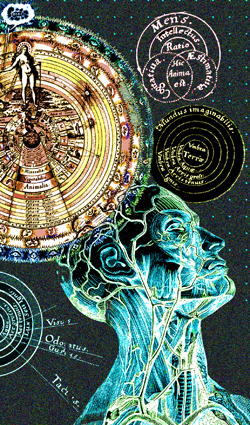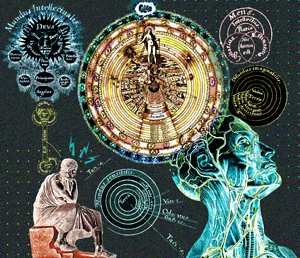What is Consciousness?

Illustration by Pop Narkotic
The question—as fundamental and mysterious as any in the universe—intrigues an array of scientists and philosophers today as it has for centuries.
Scientists, philosophers, researchers, scholars, artists, students and humanists from around the world will convene in Tucson this month to speak, listen, discuss, debate and present their ideas on the exact nature of consciousness.
The 2014 Toward A Science of Consciousness is the 20th anniversary of the landmark conference in Tucson that kicked off a new era of studies on the subject. The conference will reflect on the two decades of progress and dilemmas, current research and includes a “who’s who” list of presenters, including spiritual author/alternative medicine/holistic health guru Deepak Chopra, M.D., and world-renowned physicist and mathematician Sir Roger Penrose.
“Consciousness was kind of banned from science for most of the 20th century,” says Dr. Stuart Hameroff, director of the UA’s Center for Consciousness Studies. “William James popularized consciousness in psychology, but the behaviorists took over psychology and what became acceptable was anything you could measure. You can’t really measure consciousness, so consciousness became a dirty word for most of the 20th century and wasn’t really a scientific consideration.”
Hameroff, Professor Emeritus in the UA Departments of Anesthesiology and Psychology, says the scientific study of consciousness—after being spurned for so many years—emerged again in the late 1980s. Eminent scientists like Francis Crick, Penrose and others began seriously addressing consciousness, publishing books on the subject and giving it a renewed scientific acceptability.
At first relegated to the realms of very particular fields in inquiry, consciousness studies began crossing and combining disciplines and competing views emerged. The viewpoints closely aligned with ancient philosophical approaches, one more Western in describing consciousness as a by-product of brain activity and one more Eastern in considering consciousness a primary basis for reality.
“There are two basic camps, one is the brain as a computer and the second is that the brain connects our thoughts to the fundamental level of the universe,” Hameroff says. “Both of these views have come a long way (since the 1994 conference).”
Though consciousness began moving into the scientific mainstream, prior to 1994 there were only conferences with specific focus—for example on philosophy of mind, Hindu spiritual approaches, neuroscience or artificial intelligence.
“It wasn’t until our conference in 1994 that you saw an integrated approach,” Hameroff says. “You bring everybody together under one umbrella and try to break down these barriers. That first was very successful. It was phenomenal experience that galvanized the interdisciplinary approach.”
Planning the initial 1994 conference, Hameroff and his UA colleagues Alfred Kaszniak in psychology, the late Alwyn Scott in mathematics and then conference manager Jim Laukes, didn’t know what to expect. The Internet had just begun connecting scientists and philosophers from around the globe and suddenly those shared interests could be explored free from geographic boundaries.
Hameroff describes a then-unknown philosopher, Australian David Chalmers, setting the tone. Chalmers, an Oxford-educated philosopher then a professor at the University of California-Santa Cruz, framed consciousness in just the right terms.
“He talked about how problems like memory, learning, attention and behavior were relatively easy compared to the really hard problem of how and why we have conscious experience,” Hameroff says. “We could have been non-conscious, robot-like zombies with no inner life. So how and why do we have feelings and awareness? That was the hard problem and at that moment, we knew why we were there.”
After the 1994 conference, there was great demand for a follow-up and the UA began hosting the conference every other year, helping to sponsor the off-year conferences at other sites around the world, in places such as: Naples, Italy; Tokyo, Japan; Copenhagen, Denmark; Stockholm, Sweden, among many other locales.
In 1998, with a grant from the Fetzer Institute, the UA’s Center for Consciousness Studies began, with Chalmers recruited to join the philosophy department and serve as the center’s director. Chalmers, who became the UA’s youngest-ever Regents’ Professor before returning to Australia, returns as a featured speaker for this year’s conference.
Hameroff, who continues a collaboration he began with Penrose at the 1994 conference on a well-known but controversial quantum theory of consciousness, says breakthroughs in quantum brain biology have them on the verge of catching up to the computationalists.

Illustration by Pop Narkotic
“Consciousness is a fundamental, irreducible part of the universe,” Hameroff says in describing his theory. “Rather than consciousness being a property of a particle, it’s a property of the fabric of the universe. The idea is that consciousness is intrinsic to the universe and it’s built into the universe, it’s ubiquitous, it’s everywhere and what the brain does is organize it.”
As far as the science, Hameroff says both approaches have seen great progress in the 20 years since the initial conference. Major strides in brain mapping join the advances in quantum mechanics in spurring on the competing views in their own ways and continuing to build excitement for consciousness as a field of study.
The conference—from Monday, April 21 to Saturday, April 26—is expected to draw 800 scientists, philosophers, experientialists, artists and students from more than 60 countries to the University Park Marriott Hotel, 880 E. 2nd St. Seating is limited and registration is required. In addition to the keynote, Penrose will also give a public talk on astrophysics on April 21 at the UA’s Steward Observtory, 933 N. Cherry Ave.
The conference will feature presenters on both sides of the quantum-computational divide, as well as discussions of subjectivity and objectivity, near-death and out-of-body experiences, Eastern spiritual approaches, mind uploading and a revisiting of Chalmers’ “hard problem.”
Just as the Toward a Science of Consciousness conference made its mark on the world 20 years ago, this year’s version promises to define the leading edges of consciousness studies for the next decades of breakthroughs. And, Hameroff says, the UA’s prominent role in the field continues to draw global attention.
“What the future will bring, we don’t know,” Hameroff says. “Certainly in an interdisciplinary way, the conference and our center did put the University of Arizona on the map in terms of consciousness studies around the world. Ironically, on campus we’re not all that well appreciated. But worldwide, we’re very well known.”
The conference runs from Monday, April 21 to Saturday, April 26. Registration fees are $450-$550, with additional costs for workshops and other activities. For more information, visit Consciousness.arizona.edu.
Category: Community, DOWNTOWN / UNIVERSITY / 4TH AVE, Events, Living, Nature




